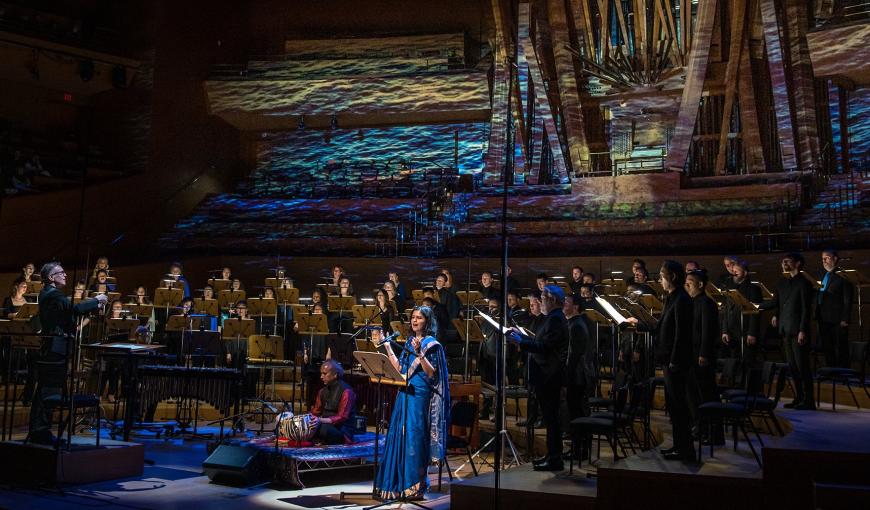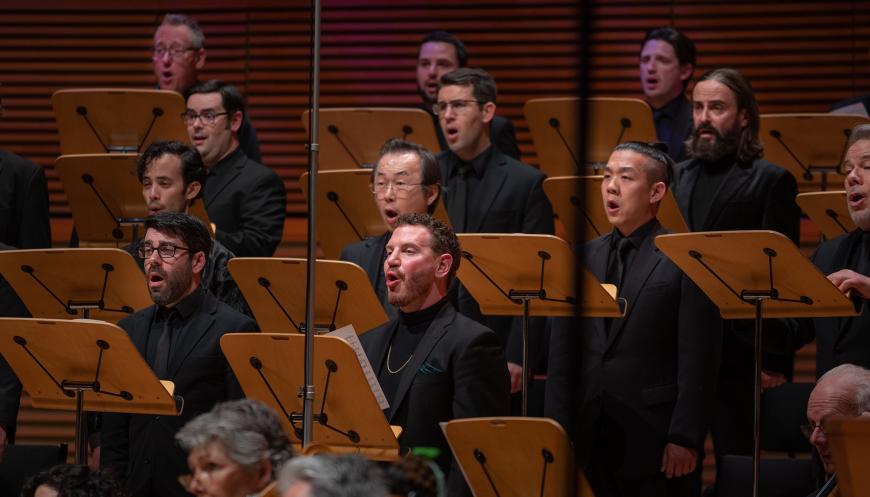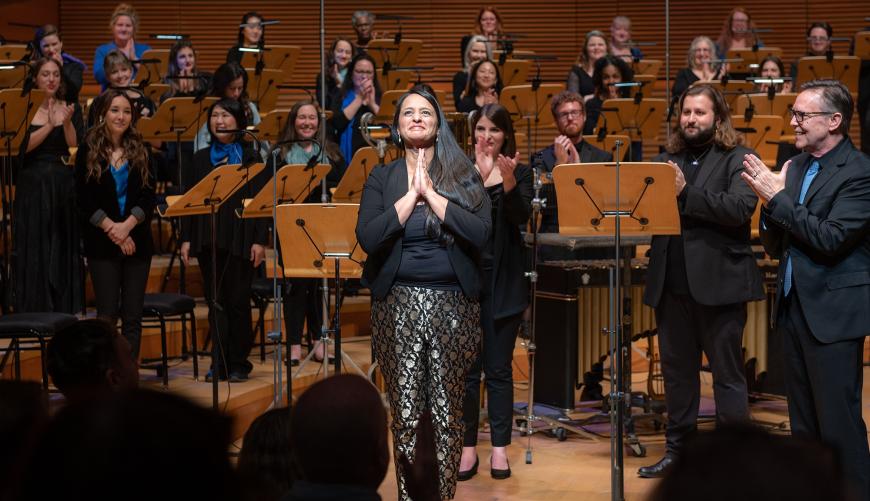
In an inventive Requiem doubleheader, the Los Angeles Master Chorale offered a powerful evening of reflection at Walt Disney Concert Hall on Sunday, March 26. Between the concert’s two substantial works — Gabriel Fauré’s popular Requiem and the world premiere of Reena Esmail’s Malhaar: A Requiem for Water — the musical landscape proved at once divergent and compatible. The durability and ongoing adaptability of the Requiem form across cultures became a strong subplot.
For the Fauré, conducting duties went to the skillful Jenny Wong, LAMC’s associate artistic director, and Disney Hall’s magnificent showpiece organ was put to good use by Jaebon Hwang. A compact chamber orchestra, featuring a glowing violin solo by Roger Wilkie in the Sanctus, supplied the instrumental foil for the ever luminous Master Chorale forces. Graced by the hall’s refined acoustics, the singers commenced with the gentle Introit and moved outward and upward through the score’s multi-dynamic terrain with precision and nuance.
Fauré’s model is, by degrees, less foreboding than Germanic and Italianate examples of the Requiem, with a sensuous quality in the Agnus Dei and in the sweet, paradisiacal closure of the final In Paradisum section especially. The Los Angeles Master Chorale understood this music.

Esmail, raised and now based in Los Angeles, is LAMC’s composer-in-residence and has created a fresh and profound choral jewel with Malhaar. Having studied Western music at Juilliard and Yale before avidly pursuing a discovery of her roots and steeping herself in Hindustani music, Esmail is now busily pursuing her goal of finding fruitful aesthetic paths between Indian and Western classical sensibilities. That mission is being rewarded with ample opportunity: Malhaar was one of an astonishing 16 premieres she wrote in 2022.
Here, the subject is water — its elemental sacredness and fragile state in the world. A subtle and effectively atmospheric projection design by Camilla Tassi showed the mantra-like phrase “Water is holy,” in English and Sanskrit. Somewhat ironically, Esmail was partly inspired by the protracted drought situation in Southern California, which has been alleviated only recently by the torrential rains of early 2023. Before leading the piece, intrepid Artistic Director Grant Gershon joked that Esmail had been quoted in the Los Angeles Times as saying, “When you sing Malhaar, rain comes.” Gershon added, “I can say that our rehearsals have been successful. You’re welcome.”
But, of course, Esmail’s Malhaar is much more than an L.A. story. Universal messages are sent in a universalized language. Symbiotic elements converge in this piece, on different levels. For her text, Esmail drew on varied sources, mixing fragments of the standard Requiem Mass with water-themed segments by poets Wendell Berry and, especially, William O’Daly (who was in the house for the premiere).

Musically, Esmail interweaves the Western-leaning sound of the chorus (albeit with some Indian turns of harmonic phrase and glissandi) with the pivotal sound of a frequent collaborator, bedazzling Indian vocalist Saili Oak, along with tabla player Abhiman Kaushal as a foil for regular Master Chorale percussionist Theresa Dimond. The Indian musicians heeded the highly disciplined but also naturally improvisatory call of their lineage, seamlessly winding through the structured “paper music” nature of the chorus, which from its ranks showcased soprano Graycen Gardner and tenor Adam Faruqi, who partnered on the penultimate movement, “Question for God.”
As the seven-movement work culminated, musical ideas came together in a happy collusion. Themes from O’Daly’s “The Dream of the Waterfall” interleaved with the Requiem’s In Paradisum (typically a rare addendum to the Requiem structure and here a nod to Fauré). In a satisfying recapitulative gesture, echoes of the opening “Holy Water” section filtered in as the chorus ended with the lines of Berry’s poem of the same name: “The water is free only / in its gathering together, / in its downward courses, / in its rising into air.”
Esmail’s new piece stirred the ear and soul and proposed a surprisingly supple and affecting cultural synthesis. The Requiem lives, ever renewable in creative hands.




